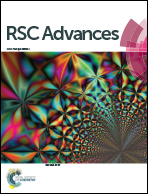Wavelength-tuneable laser emission from stretchable chiral nematic liquid crystal gels via in situ photopolymerization†
Abstract
Stretchable liquid crystal laser gels are free-standing films with emission wavelengths that may be tuned by applying a mechanical strain. These laser gels offer potential for industrial applications such as micro-actuators and pressure sensors due to their small dimensions and suitability for solution processing. Here, we demonstrate examples of such laser gels that comprise multiple regions emitting at different wavelengths, each of which may be reversibly and selectively tuned without measurable hysteresis. These gels are created from a combination of reactive and non-reactive mesogenic molecules using an in situ photo-polymerization technique that is compatible with a variety of commercially available materials and is therefore more versatile than previous methodologies for creating elastomeric liquid crystal lasers. In this paper, we vary the concentration of reactive mesogen and study the corresponding change in the mechanochromic properties of the resulting films. By doping the gels with a fluorescent dye, laser emission that can tuned continuously (by ∼40 nm) upon mechanical extension along a direction that is perpendicular to the helicoidal axis of the chiral nematic liquid crystal phase is observed. Moreover, tuning of the wavelength is found to be reversible and does not exhibit any measurable hysteresis, thereby allowing repeatable selection of a desired laser wavelength by controlling the film elongation. By virtue of the versatility of the technique, it is possible to photo-polymerise different areas of the thin-films at different temperatures to pattern the gels in such a way that different regions of the gel emit at different laser wavelengths.



 Please wait while we load your content...
Please wait while we load your content...